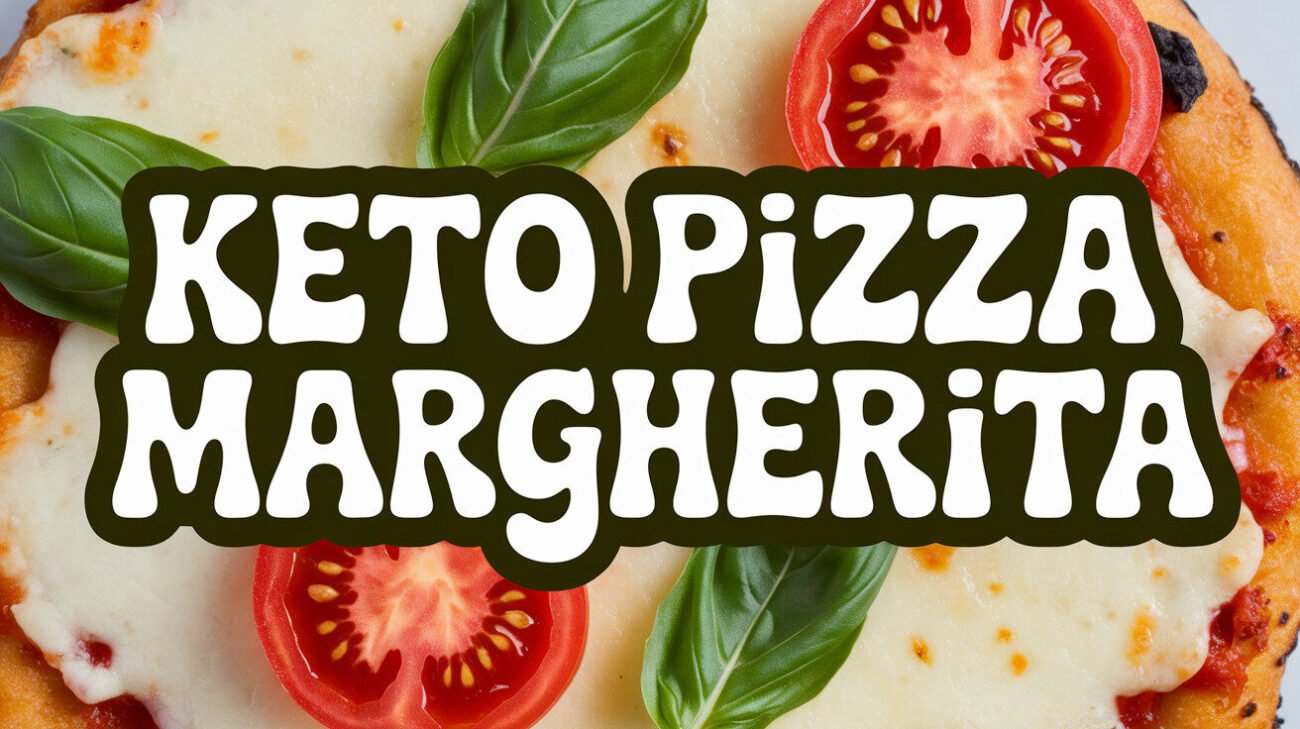Let’s be real—most keto pizza crusts are disappointing. They’re either soggy, eggy, or taste like cardboard with cheese. I’ve tested probably two dozen variations in my kitchen over the past three years, and the frustration is real. But this Keto Pizza Margherita? This is different. We’re not just making “low-carb pizza.” We’re creating something that honors the spirit of true Neapolitan pizza while staying firmly under 5g net carbs per slice. The secret isn’t some magical ingredient—it’s understanding the science of almond flour and refusing to accept soggy bottoms anymore.
Why This Isn’t Just Another Low-Carb Pizza Recipe
The Common Pitfalls of Keto Pizza Crusts
Most keto pizza failures come down to three things: moisture management, structural integrity, and flavor balance. Cauliflower crusts often steam themselves into mush. Cheese-only crusts can be greasy and overwhelming. And almond flour crusts? They frequently crumble apart or have that gritty, dense texture that makes you question your life choices. I’ve been there—standing over a pizza stone with something that resembles more of a pizza casserole than actual pizza. The industry has shifted toward fathead dough (that mozzarella-based crust) because it’s easy, but honestly? It often tastes like you’re eating baked cheese with more cheese on top. Not exactly the balanced experience we’re after.
How This Almond Flour Base Solves the Soggy Bottom Problem
After testing this specific formulation at least fifteen times, I landed on the solution: it’s all about the protein-to-fat ratio in your almond flour and proper pre-baking technique. Super-fine almond flour (not almond meal—big difference) provides the structure, while a combination of mozzarella and cream cheese creates pliability without making the crust greasy. The real game-changer? Using a pizza stone preheated for a full hour at 450°F. That initial thermal shock creates tiny steam pockets while immediately setting the crust’s structure, preventing moisture from the toppings from seeping down. It’s the same principle professional pizzerias use, just adapted for our low-carb ingredients.
Gathering Your Ingredients for Authentic Flavor
The Almond Flour Crust Arsenal
You’ll need:
- 2 cups (224g) super-fine almond flour (I consistently get best results with Blue Diamond or Bob’s Red Mill)
- 2 cups (226g) part-skim, low-moisture shredded mozzarella (pre-shredded works fine here, surprisingly)
- 2 oz (56g) full-fat cream cheese, cubed
- 1 large egg, room temperature
- 1 tbsp (10g) psyllium husk powder (this is non-negotiable for structure)
- 1 tsp baking powder (aluminum-free works better for flavor)
- ½ tsp garlic powder
- ½ tsp dried oregano
- ¼ tsp kosher salt
The psyllium husk powder might seem unusual if you’re new to keto baking, but it’s what gives the crust that chewy, bread-like texture instead of a crumbly mess. Don’t substitute with whole husks—the texture will be off.
The Simple, Fresh Margherita Toppings
For authentic Margherita character:
- ½ cup sugar-free pizza sauce (Rao’s is my go-to—3g net carbs per ½ cup)
- 8 oz fresh mozzarella cheese, sliced into ¼-inch rounds
- ¼ cup freshly grated Parmesan cheese
- 1 large Roma tomato, thinly sliced
- ¼ cup fresh basil leaves, torn (not chopped—tearing preserves the oils)
- 1 tbsp extra virgin olive oil for finishing
- Flaky sea salt for finishing
The beauty of Margherita pizza is its simplicity—which means every ingredient needs to shine. Don’t skip the fresh basil added after baking, and that final drizzle of quality olive oil makes all the difference.
Crafting Your Keto Pizza Margherita: A Step-by-Step Guide
Mastering the Almond Flour Dough
Start by melting your cheeses—but here’s where most people go wrong. Use a double boiler or microwave in 30-second bursts, stirring between each. You’re aiming for just melted enough to combine smoothly, not hot and oily. If the mixture gets too hot, it’ll cook the egg when you add it later. I use a stand mixer with paddle attachment on low speed, but you can do this by hand with a spatula—just work quickly. Combine the almond flour, psyllium, baking powder, and seasonings in a separate bowl first. Why? Psyllium husk powder tends to clump, and you want even distribution throughout the dough. Once your cheese mixture is smooth, add the dry ingredients and egg, mixing until it forms a cohesive ball. The dough should be slightly sticky but manageable with oiled hands.
Pre-Baking for the Perfect Crisp
This step is non-negotiable for that crisp foundation. Place your pizza stone or baking sheet in the oven and preheat to 425°F for at least 45 minutes—yes, really. The stone needs time to absorb and retain that heat. While it heats, roll your dough between two sheets of parchment paper to about ¼-inch thickness. I find a rolling pin works better than hands here for even thickness. Remove the top parchment, then carefully slide the dough (on the bottom parchment) onto the preheated stone. Bake for 8-10 minutes until the edges just begin to golden. This partial bake creates a moisture barrier that prevents sauce seepage.
Assembling and Finishing Like a Pro
Assembly order matters more than you’d think. Spread sauce lightly—this isn’t Chicago deep dish. Leave a ½-inch border unsauced for proper crust formation. Layer fresh mozzarella slices, then tomato rounds. Sprinkle Parmesan evenly. Return to oven (still on parchment) for 8-12 minutes until cheese is bubbly and crust edges are deep golden. The waiting is the hardest part, but let it rest for 3-4 minutes before adding fresh basil, that drizzle of olive oil, and a pinch of flaky salt. Those final additions over the hot pizza wake up the basil oils and help the salt adhere.

Pro Tips from My Kitchen to Yours
Storage and Reheating for Maximum Freshness
Keto crusts don’t reheat like regular pizza—the almond flour can become dense if handled wrong. For leftovers (though I doubt you’ll have many), store in an airtight container with paper towels between slices to absorb moisture. To reheat, never use the microwave alone. Instead, use a skillet over medium heat for 3-4 minutes until the bottom crisps, then finish under the broiler for 1 minute to refresh the top. Alternatively, air fry at 375°F for 3-4 minutes works surprisingly well. The crust freezes well after the initial pre-bake—just wrap tightly in plastic and freeze flat. Add toppings while frozen and bake 12-15 minutes from frozen.
Customizing Your Keto Pizza Creation
While Margherita is classic, this crust can handle experimentation. For pepperoni: pat dry with paper towels before adding to prevent grease pooling. For meat lovers: pre-cook meats thoroughly to render fat. For veggie: sauté mushrooms and peppers first to reduce water content. The basic crust formula is versatile—you can add 1 tbsp of Italian seasoning to the dough, or swap garlic powder for onion powder. Just maintain the wet-to-dry ratios. I’ve successfully added 2 tbsp of nutritional yeast for a cheesier flavor profile without affecting the texture.
Frequently Asked Questions
Can I use coconut flour instead of almond flour for this keto pizza?
Technically yes, but you’d need to completely reformulate the recipe—it’s not a 1:1 substitution. Coconut flour absorbs significantly more moisture than almond flour. If you try straight substitution, you’ll end up with a dry, crumbly mess. I’d recommend finding a recipe specifically designed for coconut flour rather than adapting this one.
How many net carbs are in a slice of this Keto Pizza Margherita?
When cut into 8 slices, each slice contains approximately 4-5g net carbs, depending on your specific ingredient brands. The majority comes from the almond flour and sauce. Using Rao’s sauce (3g net carbs per ½ cup) keeps it lower than many store-bought options.
Why did my almond flour pizza crust turn out crumbly?
This usually means either your almond flour was too coarse, you overbaked the crust, or you didn’t use psyllium husk powder. Psyllium is crucial for binding and creating that bread-like texture. Also, make sure you’re measuring almond flour correctly—spoon into measuring cup and level, don’t pack it down.
Can I make the keto pizza dough ahead of time?
Absolutely. The dough ball wraps well in plastic and refrigerates for up to 3 days. Let it come to room temperature for 30 minutes before rolling out. You can also freeze the dough for up to 3 months—thaw overnight in refrigerator before using.
What’s the best cheese to use for an authentic Margherita taste on keto?
Fresh mozzarella is traditional, but it contains more moisture than the low-moisture shredded kind. That’s why we use both—low-moisture in the crust for structure, fresh on top for authentic flavor and melt. The fresh mozzarella’s higher moisture content actually works well here since it’s added after the initial pre-bake.
Is this almond flour crust suitable for a dairy-free diet?
Not as written—both the crust and toppings contain dairy. For dairy-free, you’d need to substitute the cheeses in the crust (a combination of vegan mozzarella and cream cheese might work) and use dairy-free toppings. The texture will be different, but potentially still good.
How do I get my keto pizza crust crispy instead of soft?
Three key factors: preheated baking surface (stone or steel is best), proper pre-baking before adding toppings, and rolling the crust thin enough (¼-inch is ideal). Also, make sure your almond flour isn’t old—the natural oils can go rancid and affect browning.
Andreas – Keto recipe creator who lost 40lbs and discovered his love for low-carb cooking. 300+ tested recipes | 5 years of keto experience | Real food for real people. No certifications, just results that taste amazing!
